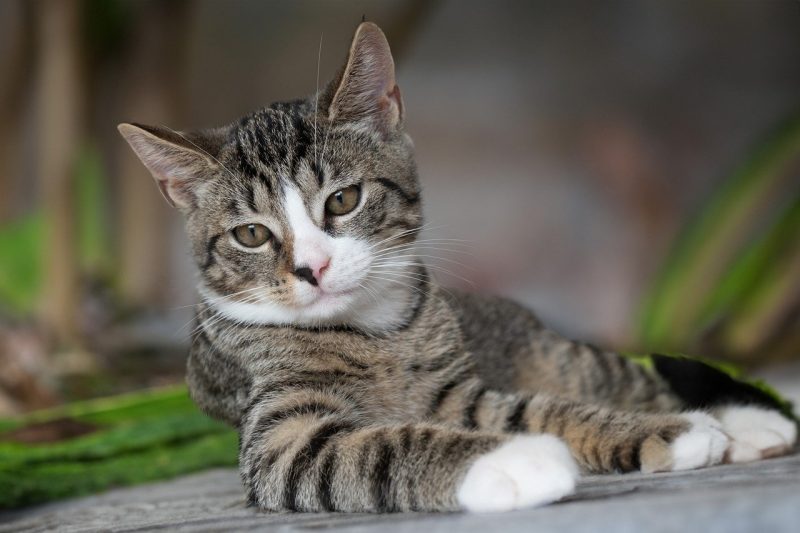
Cats Communicate Through Their Tails
Curious? Why do cats wag their tails while lying down. Cats primarily rely on their tails to express themselves, showcasing a fascinating array of signals. The various movements and positions of a cat’s tail can reveal a multitude of feelings and states of mind in the unique language of felines.

Common Behavior: Tail Wagging While Lying Down
A common behavior observed in cats is tail wagging while they are lying down. This position is often associated with moments of relaxation and contentment for our feline friends. It’s like a little signal they give off to show that they are feeling good and at ease.
Expressing Emotions Through Tail Wagging
When a cat wags its tail while lying down, it can also indicate playfulness or a desire for attention. Just like how a wagging tail in dogs can signify excitement, in cats, it might be their way of expressing a playful mood or seeking some interaction from their favorite human.
Subtle Signals in a Relaxed Pose: Why Do Cats Wag Their Tails While Lying Down?
While being in a relaxed lying position, cats may exhibit various tail movements that hint at their underlying emotions. Understanding these subtle signals can provide valuable insights into your cat’s state of mind and help you respond accordingly to nurture a strong bond.
Interpreting Cat Tail Language
The speed and direction of tail wagging can convey different meanings. Cats use their tails to communicate in a distinct way, and being attentive to these signals can provide important insights into their emotions. Along with tail gestures, taking note of other body language signs like ear placement and eye expressions can give a better understanding of your cat’s general temperament.
Reasons for Tail Wagging While Lying Down
Expressing Contentment and Relaxation
When your furry feline friend is lounging around, lazily flicking their tail from side to side, it’s likely a sign of pure contentment. This gentle wagging motion often indicates that your cat is feeling completely at ease and relaxed in their environment. It’s like they’re saying, “Life is good, and I’m loving every moment of it.”
Signaling Playfulness
Sometimes, cats can’t contain their playful spirits even when they’re taking a well-deserved rest. If you notice your cat’s tail swishing more energetically while they’re lying down, it could be a clear indicator of their playful mood. They might be daydreaming about chasing imaginary prey or eagerly waiting for you to engage them in a fun game of string or feather toy.
Expressing a Desire for Attention
Cats are known for their subtle ways of seeking attention, and tail wagging while lying down can be one of those hints. If your cat gently wags their tail while looking at you with those big, irresistible eyes, they might be subtly asking for some pets, cuddles, or interactive playtime. It’s their way of saying, “Hey, human, I’m here, and I wouldn’t mind a little love and attention from you.”
Interpreting Cat Tail Language
The Speed and Direction of Tail Wagging

When your cat wags its tail while lying down, pay attention to the speed and direction of the movement. A slow and gentle wag usually indicates contentment and relaxation. On the other hand, a fast and vigorous wag could mean excitement or agitation.
Understanding Other Body Language Cues
While tail wagging is an important indicator of your cat’s mood, it’s essential to consider other body language cues as well. For example, if your cat’s ears are forward and it’s making eye contact, the tail wagging might suggest playfulness or a desire for interaction. However, if the ears are flattened and the body is tense, the tail wagging could signal irritation or discomfort.
Observing Overall Mood
To get a complete picture of your cat’s emotional state, observe how the tail wagging fits in with the rest of its body language. Is the cat purring, kneading, or rubbing against you? These behaviors, combined with tail movements, can give you valuable insights into whether your feline friend is feeling happy, stressed, or in need of some affection.
Enhancing Communication
By learning to interpret your cat’s tail language along with its other gestures, you can strengthen the bond you share. Responding appropriately to your cat’s signals can help build trust and understanding between you and your furry companion.
- Slow and gentle tail wag: Contentment and relaxation
- Fast and vigorous tail wag: Excitement or agitation
- Forward ears and eye contact: Playfulness or desire for interaction
- Flattened ears and tense body: Irritation or discomfort
Remember, each cat is unique, so take the time to familiarize yourself with your cat’s specific tail language and behaviors to communicate effectively.
Encouraging Positive Tail Wagging
Creating a Comfortable Environment
One of the key ways to encourage positive tail wagging in your cat is by providing a comfortable environment. Cats thrive in spaces where they feel safe and secure. Ensure that your feline friend has access to cozy resting spots, scratching posts, toys, and hiding places. This will help reduce stress and promote relaxation, leading to more content tail wagging.
Engaging Playtime
Incorporating playtime into your cat’s daily routine can also play a significant role in promoting relaxed tail wagging. Cats are natural hunters and enjoy activities that mimic stalking and pouncing. Interactive toys, laser pointers, and feather wands are great options to engage your cat in playful exercises. Not only does playtime provide physical exercise, but it also stimulates your cat’s mind, keeping them mentally sharp and content.
Positive Reinforcement
Positive reinforcement is a powerful tool in strengthening the bond with your cat and encouraging positive behaviors, including relaxed tail wagging. Whenever you notice your cat wagging their tail in a calm and content manner, offer verbal praise, gentle pets, or their favorite treats. This positive association reinforces the behavior, making your cat more likely to repeat it in the future.
Conclusion: Why Do Cats Wag Their Tails While Lying Down
Understanding the Natural Behavior of Cat Tail Wagging
Cats wagging their tails while lying down is a completely natural behavior that reflects various emotions and moods. It’s essential to recognize and interpret these tail movements to deepen your bond with your feline friend.
Deepening Your Connection Through Understanding
By understanding why your cat wags its tail while lying down, you can gain valuable insights into their feelings. Whether they are content and relaxed, playful and seeking attention, or expressing other emotions, interpreting their tail language can help you respond appropriately and strengthen your relationship.
Building a Stronger Bond
Strengthening your relationship with your feline friend can be achieved by acknowledging and responding to their tail language. By providing a soothing atmosphere with inviting resting spots, participating in enjoyable activities, and offering rewards for good behavior, you can promote a sense of calm and trust, leading to a more profound and affectionate connection with your cat.
Continuing Your Journey with Your Feline Companion
As you continue to observe and understand your cat’s tail language while they lie down, remember that each interaction is an opportunity to strengthen your relationship. By responding thoughtfully to their cues and creating a positive environment, you can nurture a strong bond filled with trust and companionship.





Be the first to comment